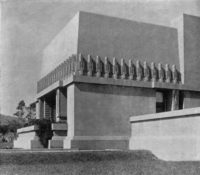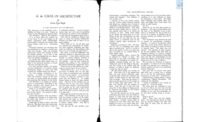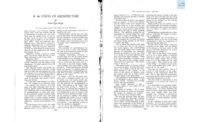It has been my hope to have inspired among my pupils a personality or two to contribute to this work, some day, forms of their own devising, with an artistic integrity that will help to establish upon a firmer basis the efforts that have gone before them and enable them in more propitious times to carry on their practice with a personal gentleness, wisdom and reverence denied to the pioneers who broke rough ground for them, with a wistful eye to better conditions for their future.
And I believe that, cleared of the superficial pose and push that is the inevitable abuse of its opportunity and its nature, and against which I ungraciously urge myself here, there will be found good work in a cause that deserves honest friends and honest enemies among the better architects of the country. Let us have done with “language” and unfair use of borrowed forms; understand that such practices or produces are not of the character of this young work. This work is a sincere endeavor to establish the ideal of an organic architecture in a new country; a type of endeavor that alone can give lasting value to any architecture and that is in line with the spirit of every great and noble precedent in the world of forms that has come to us as the heritage of the great life that has been lived, and in the spirit of which all great life to be will still be lived.
And this thing that eludes the disciple, remains in hiding from the neophyte, and in the name of which the broker seduces his client – what is it? This mystery requiring the catch phrases of a new language to abate the agonies of the convert and in the name of which ubiquitous atrocities have been and will continue to be committed, with the deadly enthusiasm of the ego-mania that is its plague? First, a study of the nature of materials you elect to use and the tools you must use with them, searching to find the characteristic qualities in both that are suited to your purpose. Second, with an ideal of organic nature as a guide, so to unite these qualities to serve that purpose, that the fashion of what you do has integrity or is natively fit, regardless of preconceived notions of style. Style is a by-product of the process and comes of the man or the mind in the process. The style of the thing, therefore, will be the man – it is his. Let his forms alone.
To adopt a “style” as a motive is to put the cart before the horse and get nowhere beyond the “Styles” – never to reach Style.
It is obvious that this is neither ideal nor work for fakirs or tyros; for unless this process is finally so imbued, informed, with a feeling for the beautiful that grace and proportion are inevitable, the result cannot get beyond good engineering.
A light matter this, altogether? And yet an organic architecture must take this course and belie nothing, shirk nothing. Discipline! The architect who undertakes his work seriously on these lines is emancipated and imprisoned at the same time. His work may be severe; it cannot be foolish. It may lack grace; it cannot lack fitness altogether. It may seem ugly; it will not be false. No wonder, however, that the practice of architecture in this sense is the height of ambition and the depth of poverty!
Nothing is more difficult to achieve than the integral simplicity of organic nature, amid the tangled confusions of the innumerable relics of form that encumber life for us. To achieve it in any degree means a serious devotion to the “underneath” in an attempt to grasp the nature of the building a beautiful building beautifully, as organically true in itself. To itself and to its purpose, as any tree or flower.
That is the need, and the need is demoralized, not served, by the same superficial emulation of the letter in the new work that has heretofore characterized the performances of those who start out to practice architecture by selecting and electing to work in a ready-made “style.”








Post a comment to this article
Report Abusive Comment